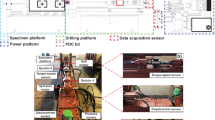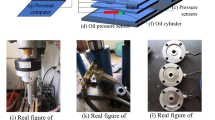Abstract
Drill sampling has been widely employed as an effective way to acquire deep samples in extraterrestrial exploration. A novel sampling method, namely, flexible-tube coring, was adopted for the Chang’e mission to acquire drilling cores without damaging stratification information. Since the extraterrestrial environment is uncertain and different from the terrestrial environment, automated drill sampling missions are at risk of failure. The principles of drilling and coring for the lunar subsurface should be fully tested and verified on earth before launch. This paper proposes a test-bed for conducting the aforementioned experiments on earth. The test-bed comprises a rotary-percussive drilling mechanism, penetrating mechanism, drilling medium container, and signal acquisition and control system. For granular soil, coring experiments indicate that the sampling method has a high coring rate greater than 80%. For hard rock, drilling experiments indicate that the percussive frequency greatly affects the drilling efficiency. A multi-layered simulant composed of granular soil and hard rock is built to test the adaptability of drilling and coring. To tackle complex drilling media, an intelligent drilling strategy based on online recognition is proposed to improve the adaptability of the sampling drill. The primary features of this research are the proposal of a scheme for drilling and coring a test-bed for validation on earth and the execution of drilling experiments in complex media.
Similar content being viewed by others
References
BAR-COHEN Y, ZACNY K. Drilling in extreme environments[M]. Weinheim: WILEY-VCH, 2009: 347–541.
DENG Zongquan, TIAN Ye, TANG Dewei, et al. Research on new structure coring bit for extraterrestrial bodies exploration[J]. Journal of Mechanical Engineering, 2013, 49(10): 104–110. (in Chinese)
ALLTON J H. Catalog of Apollo lunar surface geological sampling tools and containers[R]. Lockheed Engineering and Sciences Company, 1989: 6–20.
BERRY R L. Launch window and translunar, lunar orbit, and transearth trajectory planning and control for the Apollo 11 lunar landing mission[M]. American Institute of Aeronautics and Astronautics, 1970.
ZACNY K. Drilling systems for extraterrestrial subsurface exploration[J]. Astrobiology, 2008, 8(3): 665–706.
MATTI A. Concept evaluation of mars drilling and sampling instrument[D]. Helsinki, Finland: Helsinki University of Technology, Laboratory of Space Technology, 2005: 142–145.
PAULSEN G, ZACNY K, CHU P, et al. Robotic drill systems for planetary exploration[C]//Proceedings of AIAA Space 2006 Conference and Exposition, San Jose, California, September 19–21, 2006.
BLACIC J, DREESEN D, MOCKLER T. The 3rd dimension of planetary exploration deep subsurface drilling[C]// Proceedings of AIAA Space 2000 Conference and Exposition, Long Beach, California, September 19–21, 2000.
MARCHESI M, CAMPACI R, NISTA A, et al. Comet sample acquisition for Rosetta lander mission[R]. European Space Agency, (Special Publication) ESA SP, 2001: 91–96.
FINZI A E, ZAZZERA F B, DAINESE C, et al. Space science reviews: SD2-how to sample a comet[M]. Berlin: Springer-Verlag, 2007: 281–299.
MAGNANI P G, RE E, YLIKORPI T, et al. Deep drill(DeeDri) for Mars application[J]. Planetary and Space Science, 2004: 79–82.
OKON A. Mars science laboratory drill[C]//Proceedings of the 40th Aerospace Mechanisms Symposium, NASA Kennedy Space Center, May 12–14, 2010: 1–16
VAN WINNENDAEL M, BAGLIONI P, VAGO J. Development of the ESA ExoMars rover[C]//Proceedings of the 8th International Symposium on Artificial Intelligence, Robotics and Automation in Spacee-iSAIRAS, Munich, Germany, 2005.
KEMURDZHIAN A L, GROMOV V V, CHERKASOV I I. Automatic stations for investigation of the lunar surface[M]. Moscow: Mashinostroyeniye Press, 1976.
ZACNY K, PAULSEN G, DAVIS K, et al. Honeybee robotics planetary drill systems[C]//Proceedings of the 39th Lunar and Planetary Science Conference, Lunar and Planetary Science XXXIX, League City, Texas, 2008: 1391–1355.
GLASS B, CANNON H, BRANSON M, et al. DAME: planetary-prototype drilling automation[J]. Astrobiology, 2008: 653–664.
STATHAM S M. Autonomous structural health monitoring technique for interplanetary drilling applications using laser doppler velocimeters[D]. Georgia Institute of Technology, 2011.
GROMOV V. Physical and mechanical properties of lunar and planetary soils[J]. Earth Moon and Planets, 1999 (80): 51–72.
MITCHELL J K, HOUSTON W N, SCOTT R F, et al. Mechanical properties of lunar soil: Density, porosity, cohesion and angle of internal friction[C]//Proceedings of the third Lunar Science Conference, Cambridge, MA: M.I.T. Press, 1972: 3235–3253.
CARRIER W D, OLHOEFT G R, MENDELL W. Physical properties of the lunar surface[M]//HEIKEN G H, VANIMAN D T, FRENCH B M. Lunar Sourcebook. Cambridge: Cambridge University Press, 1991: 475–594.
MATIJEVIC J R, CRISP J, BICKLER D B, et al. Characterization of the Martian surface deposits by the Mars pathfinder rover, Sojourner[J]. Science, 1997, 278(5344): 1765–1768.
LEONOVICH A K, GROMOV V V, DMITRIEV A D, et al. Investigation of the physical and mechanical properties of lunar sample brought by Luna-20 and along the route of motion of Lunochod 2[C]//Proceedings of the 24th IAF Congress, Baku, USSR, 1973. Oxford: Pergamon Press, Ltd., 1976: 321–332.
ARVIDSON R E, ANDERSON R C, BARTLETT P, et al. Localization and physical properties experiments conducted by Spirit at Gusev crater[J]. Science, 2004, 305(5685): 821–824.
ARVIDSON R E, ANDERSON R C, BARTLETT P, et al. Localization and physical properties experiments conducted by Opportunity at Meridiani planum[J]. Science, 2004, 306(5702): 1730–1733.
HONG W. Modeling, estimation, and control of robot-soil interactions[D]. Massachusetts, USA: Massachusetts Institute of Technology, 2001.
DUNCAN J M, CHANG C Y. Non-linear analysis of stress and strains in soils[J]. Journal of the Soil Mechanics and Foundation Division, 1970, 96(5): 1629–1653.
KONDNER R L. Hyperbolic stress-strain response: cohesive soils[J]. Journal of the Soil Mechanics and Foundation, 1963, 89(1): 115–143.
AVRIL S, BONNET M, BRETELLE A S. Overview of identification methods of mechanical parameters based on full-field measurements [J]. Experimental Mechanics, 2008, 48: 381–402.
MAHNKEN R, STEIN E. A unified approach for parameter identification of inelastic material models in the frame of the finite element method[J]. Computer Methods in Applied Mechanics and Engineering, 1996, 136: 225–258.
RECHEA C, LEVASSEUR S, FINNO R. Inverse analysis techniques for parameter identification in simulation of excavation support systems[J]. Computers and Geotechnics, 2008, 35: 331–345.
RAMM A G. A uniqueness theorem for two-parameter inversion[J]. Inverse Problems, 1988(4): 7–10.
ZENTAR R, HICHER P Y, MOULIN G. Identification of soil parameters by inverse analysis[J]. Computers and Geotechnics, 2001, 28: 129–144.
MILLAR D L. Automated back analysis of ground response in rocks and soils via evolutionary computing[C]//ISRM. International Symposium-EUROCK 96, International Society for Rock Mechanics, 1996: 975–982.
GIODA G, SAKURAI S. Back analysis procedures for the interpretation of field measurements in geomechanics[J]. International Journal for Numerical and Analytical Methods in Geomechanics, 1987, 11(6): 555–583.
GIODA G, JURINA L. Numerical identification of soil-structure interaction pressures[J]. International Journal for Numerical and Analytical Methods in Geomechanics, 1981, 5(1): 33–56.
CALVELLO M, FINNO R J. Selecting parameters to optimize in model calibration by inverse analysis[J]. Computers and Geotechnics, 2004, 31: 411–425.
KELESSIDIS V C, ERGIN H. Analysis and optimization of drilling operating parameters in coring and drilling operations[C]// Proceedings of the 22nd World Mining Congress and Expo 2011, Istanbul, Turkey, 2011: 11–16.
Author information
Authors and Affiliations
Corresponding author
Additional information
Supported by National Natural Science Foundation of China(Grant No. 51105092), Introducing Talents of Discipline to Universities(111 Program, Grant No. B07018), Heilongjiang Postdoctoral Grant(Grant No. LBH-Z11168), and China Postdoctoral Science Foundation(Grant No. 2012M520722)
SHI Xiaomeng, born in 1986, is currently a PhD candidate at Research Center of Aerospace Mechanism Control, Harbin Institute of Technology, China. He received his master’s and bachelor’s degree from Harbin Institute of Technology, China, in 2008 and 2010, respectively. His research interests include extraterrestrial planet unmanned sampling.
DENG Zongquan, born in 1956, is currently a professor and a PhD candidate supervisor at the Research Center of Aerospace Mechanism Control, Harbin Institute of Technology, China. His research interests include extraterrestrial planet unmanned sampling.
QUAN Qiquan, born in 1983, is currently an inspector at Research Center of Aerospace Mechanism Control, Harbin Institute of Technology, China. His research interests include extraterrestrial planet unmanned sampling, mobile robots, and ultrasonic sampling.
TANG Dewei, born in 1966, is currently a professor and a PhD candidate supervisor at Research Center of Aerospace Mechanism Control, Harbin Institute of Technology, China. His research interests include extraterrestrial planet unmanned sampling, pipe robots, and gear transmission.
HOU Xuyan, born in 1981, is currently an inspector at Research Center of Aerospace Mechanism Control, Harbin Institute of Technology, China. His research interests include extraterrestrial planet unmanned sampling and DEM simulation.
JIANG Shengyuan, born in 1969, is currently a professor at Research Center of Aerospace Mechanism Control, Harbin Institute of Technology, China. His research interests include extraterrestrial planet unmanned sampling.
Rights and permissions
About this article
Cite this article
Shi, X., Deng, Z., Quan, Q. et al. Development of a drilling and coring test-bed for lunar subsurface exploration and preliminary experiments. Chin. J. Mech. Eng. 27, 673–682 (2014). https://doi.org/10.3901/CJME.2014.0508.088
Received:
Revised:
Accepted:
Published:
Issue Date:
DOI: https://doi.org/10.3901/CJME.2014.0508.088




